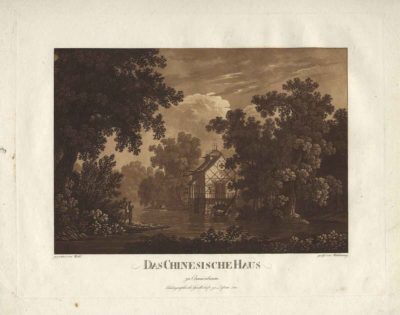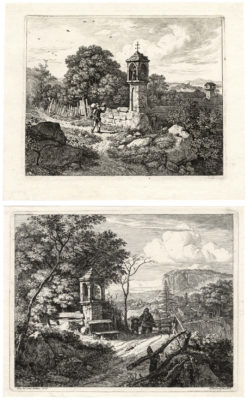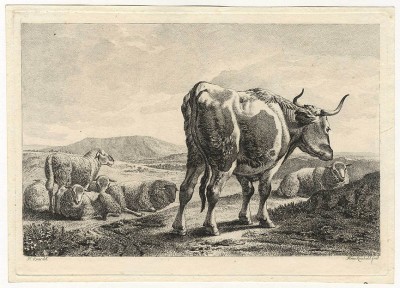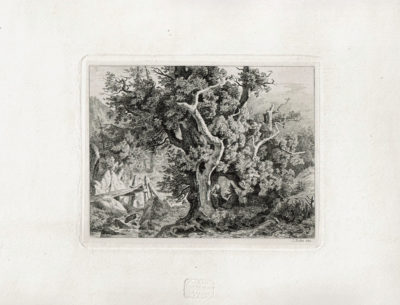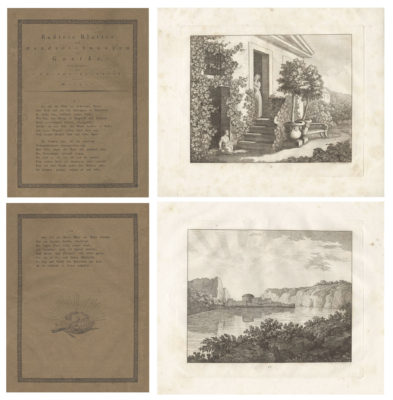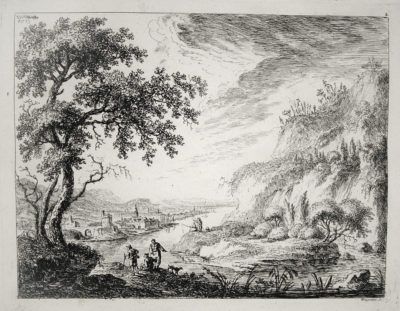NATURE AND LANDSCAPE
The artistic sublimation of nature into landscape presupposes a separation between nature and its beholder. Only when we can observe nature from the safety of civilization can we enjoy it for its beauty as well as for its ominous and dangerous qualities. However, this separation comes at a price. As early as 1757 Salomon Gessner laments the “unglykliche Entfernung von der Natur” (unfortunate distancing from nature), and a decade later Denis Diderot was the first to observe that city dwellers put up landscape images in their urban salons to compensate for the loss of nature in their daily lives. Art stepped into this ever-widening gap between us and a nature that was more and more exploited and often even destroyed. It was able to play this role so successfully that when Jacob Burckhardt was commissioned to write the entry on “landscape painting” for the ninth edition of Brockhaus’ Real-Encyklopädie in 1845, he described the “wilde Regellosigkeit” (wild unruliness) of the genre. In whatever limited way, the variety of prints presented here are meant to serve as a reflection of these artistic developments in the medium of print.
Click images to toggle info
-
![CHRISTIAN HALDENWANG 1770 Durlach – Bad Rippoldsau 1831Das chinesisches Haus zu Oranienbaum (after a drawing by HEINRICH THEODOR WEHLE) 1800]()
CHRISTIAN HALDENWANG
1770 Durlach – Bad Rippoldsau 1831
Das chinesisches Haus zu Oranienbaum (after a drawing by HEINRICH THEODOR WEHLE) 1800
etching and aquatint on wove paper; 260 x 335 mm (10 1/4 x 13 3/16 inches)
LITERATURE
Dessau (1996), no. 143
For the Friends of Nature and Art: The Garden Kingdom of Prince Franz von Anhalt-Dessau in Age of Enlightenment, Ostfildern-Ruit 1997, cat. no. 49A superb impression in excellent condition, with generous margins all round.
The palace of Oranienbaum is situated south of Wörlitz. Leopold III Frederick Franz, Duke of Anhalt-Dessau, known as “Prince Franz”, extended and altered the old gardens to create the first and largest English park which he renamed the “Dessau-Wörlitz Garden Realm.” A separate island garden that had been created in the eastern section of the baroque park in the earlier part of the eighteenth century was converted under Prince Franz into a unique English-Chinese (or “bric-a-brac”) garden between 1793 and 1797. The design was realized by the Oranienbaum court gardener Wilhelm Neumark. The construction of the eight bridges which connect the twelve islands as well as the pagoda building and the “Chinese House” was supervised by the prince’s director of construction Georg Christoph Hesekiel.
Based on a drawing by Wehle, Haldenwang’s print shows the “Chinese House” within its picturesque setting. The plants, however, could not have reached the height depicted by the time the drawing and the print were done.
Haldenwang trained under Christian Mechel. The quality of his aquatints led to his employment by the Chalcographische Gesellschaft in Dessau where he started to work in 1796 and where the present print was also published.
-
![JOHANN FRIEDRICH MORGENSTERN 1777 – Frankfurt – 1844 Peasant Tying His Shoe by a White Horse (after PHILIPS WOUWERMAN) 1800]()
JOHANN FRIEDRICH MORGENSTERN
1777 – Frankfurt – 1844
Peasant Tying His Shoe by a White Horse (after PHILIPS WOUWERMAN) 1800
etching on laid paper; sheet 178 x 193 mm (7 x 7 5/8 inches)
Nagler 7; Andresen 5
PROVENANCE
Charles M. Lea, Philadelphia (Lugt 1662a)
Philadelphia Museum of Art (acc. no. 1928-42-2369)
de-accessioned in 2017A very good impression; in good and untreated condition with margins all round.
Johann Friedrich was the son of Johann Ludwig Ernst Morgenstern (1783 Rudolstadt–Frankfurt 1819) with whom he studied early on. He later went to Dresden and became a pupil of Johann Christian Klengel.
-
![JOHANN CHRISTOPH ERHARD 1795 Nuremberg – Rome 1822 Die zwei großen Landschaften mit den Betsäulen (Zwei Ansichten aus der Umgebung des Schneebergs) – The Two Large Landscapes with Roadside Crosses (Two Views from the Schneeberg region) 1817]()
JOHANN CHRISTOPH ERHARD
1795 Nuremberg – Rome 1822
Die zwei großen Landschaften mit den Betsäulen (Zwei Ansichten aus der Umgebung des Schneebergs) – The Two Large Landscapes with Roadside Crosses (Two Views from the Schneeberg region) 1817
etchings on wove paper; each ca. 165 x 207 mm (ca. 6 ½ x 8 ⅛ inches)
Apell 83 second state (of four) and 84 third (final) state; Heller/Andresen 10
Fine impressions with margins all round. The margins of Apell 83 slightly wider, with the blind stamp in the form of a flower of an unknown collector in the lower left corner.Erhard trained as an artist in his hometown of Nuremberg. He moved to Vienna in 1816 with his close friend, Johann Adam Klein, and stayed there until October 1819 when he traveled to Rome. He committed suicide there in 1822.
Erhard’s etchings from his Vienna period count among his masterpieces and must also be seen in the context of landscapes by his Austrian contemporaries. In 1817 he had traveled with his friends Ernst Welker and Heinrich Reinhold through the Höllenthal in Niederösterreich (Lower Austria), flanked by the Schneeberg mountain on one side and Rax mountain on the other.
This picturesque area not far from Vienna was especially popular with artists during the early nineteenth century. Erhard produced a series of etchings based on sketches he had made in the valley, published in 1818 by Ferdinand Kettner in Vienna under the title VI. Ansichten aus den Umgebungen des Schneeberges bei Wiener Neustadt (Apell 11–16).
Erhard’s two scenes from the Schneeberg region might be seen as pendants; each is dominated by a Betsäule (roadside cross) intended to suggest that the nearby buildings are under God’s protection. While one of the images shows a woman carrying wood with a child, in the other the artist depicts a man passing the cross with a pack on his back in the manner of a hiker, very much like Erhard and his companions. In both landscapes Erhard favors a detailed foreground scene over the dramatic vistas offered by the mountain ranges and this is entirely characteristic of his work of the period.
-
![PHILIPP HIERONYMUS BRINCKMANN (1709 Speyer – Mannheim 1761) Waldpartie mit hölzerner Brücke – Forest Scene with a Wooden Bridge ca. 1734–41]()
PHILIPP HIERONYMUS BRINCKMANN
1709 Speyer – Mannheim 1761
Waldpartie mit hölzerner Brücke – Forest Scene with a Wooden Bridge ca. 1734–41
etching on laid paper; 207 x 172 mm (8 1/8 x 6 3/4 inches)
Andresen 8
PROVENANCE
Philadelphia Museum of Art
(Muriel and Philip Berman Gift in 1985; acc. nos. 1985-52-17102)
de-accessioned in 2017A very good impression, printed with subtle plate-tone; in impeccable condition with wide margins all round.
Brinckmann first studied with the portrait painter Johann Georg Dathan in his hometown Speyer but ultimately turned to landscape. By 1737 he was employed as court painter at the Electoral Palatinate court in Mannheim where he was also the overseer of the paintings collection. At the time he was well respected and Goethe mentions him in his autobiographical Dichtung and Wahrheit as one of the artists who made an impression on him in his youth. Posterity was not kind to him and Thieme/Becker describe his work as “rather weak and brownish paintings.” His printed oeuvre is limited to 11 original etchings, many of them historical scenes. Our print is one of his four landscape etchings.
-
![JOHANN JAKOB DORNER THE YOUNGER (1775 – Munich – 1852)Mountain Landscape with Waterfall ca. 1815]()
JOHANN JAKOB DORNER THE YOUNGER
1775 – Munich – 1852
Mountain Landscape with Waterfall ca. 1815
etching on wove paper; 105 x 86 mm (4 1/8 x 3 3/8 inches)
annotated in pencil at lower right Dorner sc.
PROVENANCE
Adolf von Heydeck, Dessau (Lugt 2519)
his sale, Rudolph Weigel, Leipzig, May 25ff., 1857, part of lot 84 (“3 Bl. Gebirgslandschaften. Radirt. 8., qu. 4. Sehr seltene Aetzdrücke”)
John S. Phillips, Philadelphia; bequeathed in 1876 to
Pennsylvania Academy of the Fine Arts;
de-accessioned in 1985 and acquired by
Philadelphia Museum of Art
(Muriel and Philip Berman Gift in 1985; acc. nos. 1985-52-17453)
de-accessioned in 2017 -
![]()
HEINRICH REINHOLD
1788 Gera – Rome 1825
Bull with Sheep (after JOHAN HEINRICH ROOS) ca. 1809
etching on wove paper; sheet 186 x 263 mm (7 3/8 x 10 3/8 inches)WATERMARK
letters SOLOM [?]PROVENANCE
John S. Phillips, Philadelphia; bequeathed in 1876 to
Pennsylvania Academy of the Fine Arts;
de-accessioned in 1985 and acquired by
Philadelphia Museum of Art
(Muriel and Philip Berman Gift in 1985; acc. nos. 1985-52-3644)
de-accessioned in 2017Heinrich Reinhold followed his older brother Friedrich Philipp (1779–1840) to Vienna in 1807. Friedrich Philipp had arrived there two years earlier after studies in Dresden and a brief sojourn in Prague. He welcomed and supported his younger brother, shared his knowledge and experience in oil painting with him and reminded the younger Heinrich of the necessity to perfect his etching skills. The latter writes in 1808 that he is “etching landscapes after nature, directly on the copper, just to practice …”
In addition to etchings after drawings by his brother, Heinrich also used drawings by Heinrich Roos as models for his prints. These Tierstücke (animal pieces) were popular at the time and therefore provided him with a fairly reliable way to earn an income as an artist.
-
![FRIEDRICH PRELLER1804 Eisenach – Weimar 1878 Large Oak Tree in the Woods of Ilmenau with a Wooden Foot Bridge over a Stream – Große Eiche bei Ilmenau, mit einer Holzbrücke über einen Bach]()
FRIEDRICH PRELLER
1804 Eisenach – Weimar 1878
Large Oak Tree in the Woods of Ilmenau with a Wooden Foot Bridge over a Stream
etching on chine collé on card, 119 x 147 mm (4 11/16 x 5 13/16 inches)
published by Julius Kuhr in Berlin (with his blind stamp)
not in Nagler
PROVENANCE
John S. Phillips, Philadelphia; bequeathed in 1876 to
Pennsylvania Academy of the Fine Arts;
de-accessioned in 1985 and acquired by
Philadelphia Museum of Art (Muriel and Philip Berman Gift in 1985; acc. nos. 1985-52-18666)
de-accessioned in 2017Friedrich Preller’s talent was early on recognized and encouraged. Grand Duke Karl August of Saxe-Weimar sent him to study in Antwerp between 1824 and 1826. Another grant allowed him to stay in Italy from 1826 to 1831. Soon after his return he was appointed head of the drawing class at the art school in Weimar in 1832. He became famous for painting heroic landscapes, often depicting scenes from the Odyssey. His etchings of romantic landscapes are today far less known but were much admired during the artist’s lifetime. A large oak tree from the Ilmenau Forest is a re-occurring motif in many of them. Nagler remarks in his Künstler-Lexikon in 1842: “Preller also etched some beautiful landscapes which are much sought-after by art lovers.”
-
![CARL WILHELM HOLDERMANN (1783 near Kassel – Weimar (?) 1852)CARL WILHELM LIEBER (1791 – Weimar – 1861)Radirte Blätter nach Handzeichnungen von Goethe 1821]()
CARL WILHELM HOLDERMANN (1783 near Kassel – Weimar (?) 1852)
CARL WILHELM LIEBER (1791 – Weimar – 1861)
Radirte Blätter nach Handzeichnungen von Goethe 1821
set of six etchings on wove WHATMAN paper; in brown wrappers with letterpress text; overall 385 x 300 (15 x 12 inches)
published by Carl August Schwerdgeburth and printed by Caesar Mazzucchi in Magdeburg, 1821
LITERATURE
Printmaking in the Age of Goethe, London 1994, no. 148Only issue; although Goethe had already selected drawings for a second issue by the end of 1821, the project was never continued.
Holdermann worked as a painter of stage sets for the Court Theatre in Weimar where he also became a director in 1824. Lieber, a protégé of Goethe, taught as a drawing instructor at the Weimar drawing school. To accompany each of the prints, Goethe wrote six poems that were set in letterpress on the wrappers in which the portfolio was issued. His close involvement with this project further included his choosing the typeface and layout of the poems as well as placing a lengthy announcement for publication in the third volume of his periodical Ueber Kunst und Alterthum in 1822.
Goethe knew not to overestimate his artistic capabilities. In his conversations with Eckermann he once remarked: “In Italy in my fortieth year I was intelligent enough to recognize that I had no talent for the visual arts and that my efforts in this direction were misplaced.” Yet he was clearly fascinated by the possibility of treating a subject both in poetry and the visual arts. In the announcement he writes: “The undertaking of several worthy artists to edit etched plates after my drawings must be welcome to me in more than one sense. As music is welcome to the poet … so it is a pleasure to see here old long-faded sheets rescued from the stream of Lethe. … And he who is not in a position to create himself, will … profit from intercourse with creative men, and, if not on this side, at least from another side form and educate himself. With the feeling that these sketches that are now laid before the public cannot entirely overcome their inadequacies themselves, I have added a small poem to each, so that their inner meaning can be perceived, and the viewer might be laudably deceived, as if he saw with this eyes what he feels and thinks, that is a closeness to the state in which the draughtsman found himself when he committed his few lines to paper.”
-
![FRANZ EDMUND WEIROTTER1733 Innsbruck – Vienna 1771 Views of Italy 1759]()
FRANZ EDMUND WEIROTTER
1733 Innsbruck – Vienna 1771
Views of Italy 1759
suite of twelve etchings on laid paper; ten printed in pairs on one sheet, one on a smaller sheet (still with margins), and the title-page on a single sheet
each ca. 6 ½ x 8 ¼ inches; the title-page 7 ¼ x 10 5/8 inches
Nagler 5
WATERMARK
grapesAlthough these views were made in Rome and its environs (e.g. Tivoli and Viterbo), they are not generally of well-known monuments or vistas but show genre-like scenes from the Italian countryside, often depicting relatively modest structures with nearby ruins and generally populated with people fishing, talking, preparing food, or otherwise busily engaged.
-
![FRANZ EDMUND WEIROTTER1733 Innsbruck – Vienna 1771 Paysages – Landscapes 1759]()
FRANZ EDMUND WEIROTTER
1733 Innsbruck – Vienna 1771
Paysages – Landscapes 1759
the complete set of six etchings; each ca. 7 x 9 ½ inches
Nagler 22Weirotter received his first artistic training in his hometown Innsbruck as well as Vienna before he went to Mainz to briefly work for Elector Johann Friedrich Karl. In 1759 he went to Paris where he became and student and later assistant to Johann Georg Wille who became an important supporter. From October 1763 he went to Rome where he stayed for one year and made acquaintances with both Winckelmann and the historian Hans Heinrich Füssli. Back in Paris he lived with Claude-Henri Watelet who had been in Rome at the same time as Weirotter. At the end of 1766 his friend Jakob Matthias Schmutzer recommended him to the Kupferstecherakademie (Engravers’ Academy) in Vienna where Weirotter started to teach in April of the following year.
Stylistically, Weirotter first emulated the art of the Dutch landscapist of the seventeenth century whose art was highly fashionable at the time. Ironically, it was not until after he had left Paris and worked in Vienna that Hubert Robert and later also Fragonard became important influences especially for his work as a draughtsman.
Hind nots that as a printmaker Weirotter was “most successful when he keeps to plates of the small dimensions, to which his delicate and clearly etched line is fitted.” Each of these six scenes here involves waterways – rushing falls, and lakes and rivers with people walking along the shores, fishing and boating, and crossing flimsy bridges.
Uncommon as fine and homogenous set like this.


